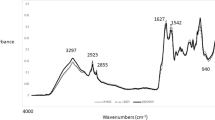Abstract
Attenuated total reflectance (ATR) infrared spectroscopy has been used to characterize pig adipocere formation. The compositions of adipocere samples obtained by burial of pig adipose tissue in soil and in mock coffins were compared with that of the original adipose tissue using this technique. The ART spectra show that bands resulting from triglyceride and fatty acid C=O stretching are particularly useful for monitoring the changes in adipocere formation. The technique is able to be used to investigate how the burial environment affects the rate of adipocere formation and supports the results of earlier gas chromatograph and mass spectrometer and diffuse reflectance infrared studies. ATR spectroscopy has also been demonstrated to have the advantage of convenient sample preparation.
Similar content being viewed by others
References
Polson CJ, Gee DJ, Knight B. The Essentials of Forensic Medicine, 4th ed. Oxford: Pergamon Press, 1985.
Bereuter TL, Mikenda W, Reiter C. Iceman’s mummification—implications from infrared spectroscopical and histological studies. Chem Eur J 1997;3:1032–1038.
Takatori T. Investigations on the mechanism of adipocere formation and its relation to other biochemical reactions. Forensic Sci Int 1996;80:49–61.
Dadour IR, Cook DF, Fissidi JN, Bailey WJ. Forensic entomology: application, education and research in Western Australia. Forensic Sci Int 2001;120:48–52.
Forbes SL, Dent BB, Staart BH. The effect of soil type on the formation of adipocere in grave soil Forensic Sci Int In press.
Forbes SL, Stuart BH, Dent BB. The effect of burial factors on the formation of adipocere in a burial environment Forensic Sci Int In press.
Forbes SL, Stuart BH, Dadour IR, Dent BB. A preliminary investigation of the stages of adipocere formation. J Forensic Sci 2004;49:566–574.
Forbes SL, Stuart BH, Dent BB. Identification of adipocere in grave soils Forensic Sci Int 2002;127:225–230.
Forbes SL, Keegan J, Stuart BH, Dent BB. Development of a gas chromatography—mass spectrometry method for the detection of adipocere in grave soils Eur J Lipid Sci Technol 2003;105:761–768.
Merrill RA, Bartick EG. Analysis of pressure sensitive adhesive tape: I Evaluation of infrared ATR accessory advance. J Forensic Sci 2000;45:93–98.
Forbes SL, Stuart BH, Dent BB. The effect of the method of burial on adipocere formation Forensic Sci Int. I In press.
Folch J, Lees M, Sloane-Stanley GH. A simple method for the isolation and purification of total lipides from animal tissues. J Biol Chem 1957;226:497–509.
Forbes SL, Stuart BH, Dent BB, Hodgson G. Studies of adipocere using diffuse reflectance infrared spectroscopy. Vib Spectrosc 2000;24:233–242.
Author information
Authors and Affiliations
Corresponding author
Rights and permissions
About this article
Cite this article
Stuart, B.H., Craft, L., Forbes, S.L. et al. Studies of adipocere using attenuated total reflectance infrared spectroscopy. Forens Sci Med Pathol 1, 197–201 (2005). https://doi.org/10.1385/FSMP:1:3:197
Accepted:
Issue Date:
DOI: https://doi.org/10.1385/FSMP:1:3:197




